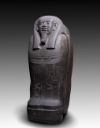A Greek in ancient Egypt?
The bottom of the coffin contains two very large columns of hieroglyphic text. The parents of Wahibreemakhet are named here again. Their names, written in hieroglyphs, are Greek: Alexikles and Zenodote (in hieroglyphs ArkzkArz and Zntty).
The Late Period (664 – 332 BCE) was characterized by close contact and cultural exchange between the Egyptian world and other civilizations outside of Egypt, for example the Greek world. King Psamtek I, the first king of the 26th Dynasty (664 – 525 BCE) (under whose reign this sarcophagus was made), made use of Greek mercenaries to acquire the Egyptian throne from the Persians. Greek mercenaries were in high demand because they were known as powerful soldiers.
People with a non-Egyptian background were able to achieve high positions within Late Period Egypt. A nice example is, of course, Wahibreemakhet himself. Although the sarcophagus does not mention his titles, his canopic jars, currently in Stockholm, do. They call him the seal-bearer of the king, a well-known administrative title.
Both archaeological and textual evidence point to the fact that Greeks and Egyptians lived side by side from the Late Period onwards. This can make it difficult to differentiate between both communities. For example, in time it became common practice for people with non-Egyptian names to adopt an Egyptian name. There is a possibility that Wahibreemakhet had a Greek name, like his parents, but had decided to adopt an Egyptian one for his public career. His sarcophagus sadly doesn’t shed any light on this issue.
As you may have noticed, a lot about the life of Wahibreemakhet remains unknown: why did he live in Egypt? Did his Greek parents also live in Egypt? If so, did they move here because of the demand for Greek mercenaries? Did Wahibreemakhet embrace Egyptian cultural norms and religious ideas?
One thing is very clear: the high quality of his sarcophagus and grave goods, in combination with his administrative title, shows that this Greek-Egyptian lived the life of the Egyptian elite. Wahibreemakhet was buried in the Egyptian way, resulting in this beautiful object that enables us to tell part of his story.
